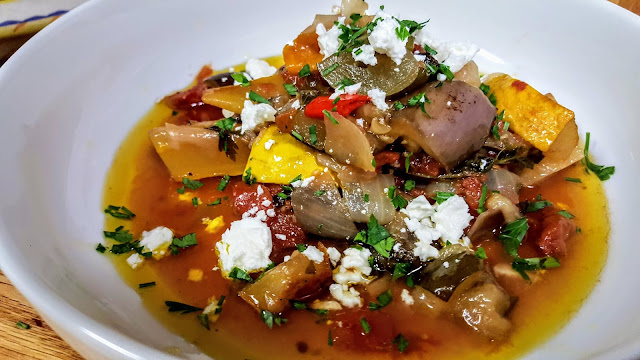Greek Ratatouille
 |
| The finished dish served up with a sprinkling of fresh parsley and crumbled feta cheese. |
My mother
didn’t have a name for this dish when she served it to us as a weekday dinner
during our immigrant years in Australia. I made it often, but it was a nameless
dish--always with great flavor, but orphaned of name. Consequently, years later
in the United States, when one of my father’s sisters, my theia Rina, was
visiting from Greece and she called this dish Tourloutourlou, I had no idea what she was cooking. Funny, however,
that she always referred to it as Tourloutourlou
and her sister, my Aunt Polly, has always called it Briam. You will hear it
called by both names, depending on the family tradition. In my family, this has
always been cooked in a pot on the stove, just like traditional Ratatouille,
using onion, garlic, olive oil, lots of parsley and whatever summer vegetables
are available to you, either from your garden, the local farmers market or the
bountiful gardens of neighbors and friends.
 |
| Use a vibrant mix of colors for an eye-pleasing dish |
Today, this dish is almost always
cooked in the oven, all vegetables carefully sliced and positioned or layered
in a roasting dish then covered in a rich tomato sauce.
 |
| Stir once during oven-roasting to get the browned edges on all of the veggies. |
My simplified version takes the worry out of keeping an eye on the pot. You toss the vegetables gently only once, and the rest of the cooking time you can do whatever you wish. Both stovetop and oven-roasted versions are simple enough, but the oven gives you greater freedom with how to use your time.
For a printable version of this recipe, click here.
For a video of me teaching you how to say Briam and Tourloutourlou, click here.
Ingredients
1 extra
large zucchini cut into large cubes or 2 “batons
1 large
yellow squash cut into large cubes or 2” batons
1 large
eggplant (or two Japanese) cut into large cubes
2 cups
snapped green beans cut into 2” pieces
1 cup
trimmed okra
1 cup of new
potatoes or any potatoes (that you have on hand) cut into large cubes
1 red pepper
ribbed, seeded and cut into 1” squares (orange, yellow or green can be used
also)
1 bunch
Italian parsley, coarsely chopped
1 large
sweet yellow onion like Vidalia (white can be substituted)
Half of one
head of garlic, peeled and cloves sliced
1 cup olive
oil
1 (14 oz) can
diced tomatoes with juice
1 (14 oz)
can crushed tomatoes
4 cups of water
salt and
pepper
Method
1. Prep all of the vegetables and open
both cans.
2. In a large roasting pan with high
sides, toss the vegetables with the tomatoes, oil, water, parsley, garlic and onion.
Season with salt and pepper.
3. Place on the middle rack of a
preheated 450F oven.
4. Roast for 45 minutes; toss gently to
bring veggies from the bottom to the top.
5. Roast for one hour. Test to make sure
that the veggies have softened and that the liquids have reduced and thickened
slightly. If they need a little longer, return to the oven for 15 minutes
longer and check again. If the sauce has thickened too much and seems too oily,
stir in another cup of water and return to the oven for another 15 minutes.
6. In the Greek heritage kitchen, this
is a complete meal and requires no meat accompaniment. It is served with crusty
bread and feta cheese on the side.
7. Leftovers can be frozen and served as
a side dish to roasted chicken, pork or fish.
The
vegetable combination used in this recipe can be amended to include fewer of
one and more of another, according to what is in season and available to you.
The seasonings (garlic, olive oil, parsley, tomato, onion) and eggplant are the
essentials of this dish. I love to use an excess of okra and often finish the
dish with frozen peas, which I stir into the pan in the last 10-15 minutes of
cooking.
This weekend I cooked from the freezer: Previously cooked Greek ratatouille that I reheated and roasted pork tenderloin. Such an easy way to cook and so affordable. All of the veggies came from friends and neighbors. All that I invested in this dinner were the seasonings, the pork loin and my time.
 |
| By federal law, no hormones or steroids used with pork. |





Comments
Post a Comment